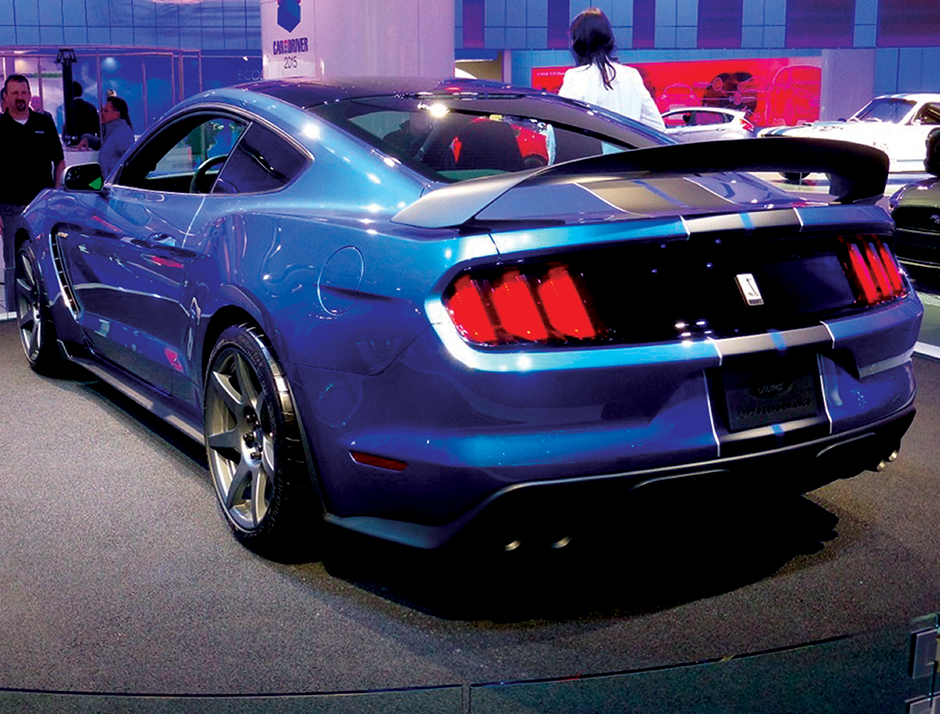Automakers Ramp up Uses of Plastics & Carbon Fiber
And it looks like this trend is only going to continue…
Previous Article Next Article
By American Chemistry Council (ACC)
Automakers Ramp up Uses of Plastics & Carbon Fiber
And it looks like this trend is only going to continue…
Previous Article Next Article
By American Chemistry Council (ACC)
Automakers Ramp up Uses of Plastics & Carbon Fiber
And it looks like this trend is only going to continue…
Previous Article Next Article
By American Chemistry Council (ACC)

Ford’s all-new GT is a high-performance production-volume sports car that’s loaded with carbon fiber-reinforced plastics.

Ford’s new Shelby GT350R Mustang’s rear wing and wheels are made from CFRPs.
Note: This article continues the series of updates in Plastics Engineering from Plastics Make it Possible®, an initiative sponsored by America’s Plastics Makers™ through the ACC.
Been to an auto showroom lately? There have been plenty of recent changes to our cars and trucks, from advanced dashboard displays to inflatable seat belts, many of them based on innovations in plastics.
Last year an ACC article in Plastics Engineering (June 2014, p. 34) highlighted the U.S. introduction of BMW’s i3, an electric car that sold out immediately and continues to have a long waiting list of buyers. The i3 was the first mass-produced vehicle with a major component—the passenger compartment—made from carbon fiber-reinforced plastics (CFRPs), the materials Boeing is using to build its Dreamliner.
CFRP materials in cars are a big deal because they’re up to ten times stronger than steel, fifty percent lighter than steel, and thirty percent lighter than aluminum. Carmakers are counting on CFRP and other lightweight performance plastics to reduce the weight of autos so they can meet the CAFE standard of 54.5 miles per gallon by 2025. Plus, CFRP auto components have a much higher energy-absorption rate than steel, which can contribute to improved safety in a collision.
So what’s new with cars and plastics in 2015? Let’s take a selective look at some new advances in sustainability made possible by plastics, at one of the world’s largest car makers: Ford Motor Company.
CFRP in the GT
In March 2015, Ford unveiled the all-new GT, a high-performance production-volume sports car that is loaded with CFRP. The GT’s passenger cell is made of CFRP, and its front and rear subframes are wrapped in structural CFRP body panels. In its news release announcing the GT, Ford said the composite “is one of the world’s strongest materials for its mass—enabling an ultra-stiff foundation for chassis components, while creating a lighter overall package for increased dynamic performance and efficiency…. With the broad application of structural [CFRP] elements, the GT will exhibit one of the best power-to-weight ratios of any production car.”
But here’s the real benefit, according to Ford: “Few innovations provide a more wide-ranging performance and efficiency advantage than reducing weight. All factors of a vehicle’s capabilities—acceleration, handling, brak- ing, safety, efficiency—can improve through the use of advanced, lighter materials.”
And it won’t stop with the GT; Ford said it will use this technology broadly across its future lineup. The “GT includes innovations and technologies that can be applied broadly across Ford’s future product portfolio…. [For example,] the all-new GT features advanced lightweight composites, which will help serve Ford’s entire product lineup moving forward.”
Joint Ventures
One early example of the broader use of this technology is Ford’s new Shelby GT350R Mustang. It has a CFRP rear wing and comes standard with CFRP wheels, reducing weight by 13 pounds (5.9 kg) per wheel while offering higher levels of stiffness than aluminum wheels. As a Ford vice president put it, “Obviously the carbon fiber wheels have been really exciting to work with. That’s a real first and helps get a little bit more stance in the car, as well.” (Stance means lowering the chassis closer to the pavement.)
Much work is underway to meet this growing demand for CFRP in autos. Ford and DowAksa (a 50/50 joint venture between Dow Chemical and the Turkish fibers-producer Aksa Akrilik Kimya Sanayii A.Ş.) have been working together to bring down costs and increase the availability of carbon fiber, while developing a high-volume manufacturing process for CFRP parts. Ford and DowAksa also are part of the newly formed U.S. Institute for Advanced Composites Manufacturing Innovation, created to develop low-cost, high-production, energy-efficient manufacturing and recycling processes for composites applications.
By the way, Ford is not alone in this effort in the USA. BMW said it expects to triple capacity at its U.S. carbon fiber production plant in Moses Lake, Washington, in 2015, making it the world’s largest carbon fiber plant. The company announced it plans to use “the ultra-lightweight, high-tech material for other model series at competitive costs and in large quantities.”
Similar to Ford’s and other investments in the U.S., BMW, Audi, and 70+ companies and organizations are backing a materials development group in Europe that says it’s getting closer to large-scale manufacturing of cars made with CFRP. MAI Carbon Cluster Management, an €80 million ($90 million) research effort supported by Germany’s federal government, businesses, and research institutions, is making progress toward its goal of cutting carbon fiber production costs by a whopping 90%.
Based on these and other investments, one researcher recently predicted that use of CFRP in autos will dwarf current applications in the coming decade, driven by a faster-than-expected pace of technology development that will lead to widespread adoption for automotive lightweighting by 2025. Advances in carbon fiber, resin, and composite part production already underway are expected to lead to a $6 billion market for automotive CFRP in 2020, which could balloon well beyond that figure, depending on the affordability of materials.
Based on Ford’s and other investments, suffice it say that CFRP now appears headed toward mainstream use over the next decade.
Performance Plastics in the F-150
Beyond CFRP, performance plastics continue to enable advances in cars. While its aluminum alloy body has captured most of the attention, the Ford F-150 pickup truck incorporates the first all-plastic molded lens for both the low- and high-beam LED headlamps that focuses light beams, reducing light diffusion. The shatter-resistant lamps are brighter, more efficient, and last longer than conventional lamps, which is critical for off-road vehicles whose lamps are subjected to all sorts of shocks. Bayer MaterialScience’s optical grade polycarbonate is used in the lens for optical efficiency. Polycarbonate also enables greater design freedom compared with traditional multi-lens designs, as well as reduced cycle times and cost compared with glass.
The F-150’s aluminum alloy body actually created a challenge that plastics were able to solve. The F150’s aluminum bumper does not permit typical installation of a blind-spot information system (BLIS) sensor behind a plastic fascia, so the BLIS has been uniquely integrated into the plastic rear tail-lamp assembly. By installing the BLIS system in the tail lamp, the lens cover also protects the module from direct impact, water, mud, and snow.
Recycled Plastics in Focus
While plastics contribute to sustainability in automobiles predominately through lightweighting, which dramatically reduces energy use and the resulting emissions, the use of recycled plastics in auto parts can further contribute.
Ford uses recycled plastics to create upholstery for passenger seat cushions in numerous models. For example, the seat fabric for each Focus is made with approximately 22 plastic water bottles, and 100% recycled content fibers from Repreve are used in the 2015 F-150, diverting more than five million plastic bottles from landfills this year. The company also used more than 50 million pounds (23 million kg) of post-consumer recycled plastics on the exterior of Ford vehicles made in North America—that equals nearly 18 pounds (8.2 kg) per vehicle on average.
Looking to the Future
Today’s autos already are approximately 10% plastics by weight—but half the volume of each vehicle, on average, is actually made from plastics: in bumpers, door panels, seating, dashboards, carpeting, lighting, insulation, and more and more parts under the hood. The list grows every year, based on the contributions of plastics to sustainability, safety, and design. Perhaps that’s why industry experts predict plastics’ use in vehicles will increase 75% by 2020.
